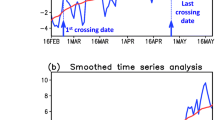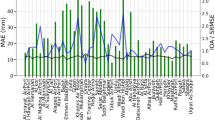Abstract
The interannual variability of East African ‘short rains’ (EASR) and its link with the Mascarene High (MH) variation are explored, using observations and reanalysis data. Correlation and composite analyses for flood and drought events reveal that the EASR variability is strongly linked to the MH zonal displacement, in particular, the zonal movement of the MH eastern ridge. When the MH eastern ridge is anomalously displaced to the west (east) of its normal position, the south east (SE) trade winds over the South Indian Ocean (SIO) anomalously strengthen (weaken). This enhances (reduces) the relatively cool and dry SE trade winds and induces cold (warm) sea surface temperature anomaly in the SIO. As a result, convection over the western equatorial SIO is suppressed (enhanced) and leads to rainfall deficits (excess) over East Africa. Droughts in East Africa are associated with a westward migration of the MH eastern ridge, while the relationship is less clear for flood events and their link to an eastward migration of the MH. Therefore, the zonal migration of the MH eastern ridge provides a novel indicator for the EASR extremes especially droughts. This revelation has immense social application for rainfall forecast over East Africa where rainfall deficits have become more prevalent against the background of deteriorating conventional forecasts for EASR droughts.












Similar content being viewed by others
References
Adler RF, Huffman GJ, Chang A, Ferraro R, Xie P, Janowiak J, Rudolf B, Schneider U, Curtis S, Bolvin D, Gruber A, Susskind J, Arkin P (2003) The Version 2 Global Precipitation Climatology Project (GPCP) monthly precipitation analysis (1979-present). J Hydrometeorol 4:1147–1167
Anyamba EK, Ogallo LJ (1985) Anomalies in the wind field over east Africa during the east African rainy season of 1983/1984. Proceedings of the first WMO workshop on diagnosis and prediction of monthly and seasonal atmospheric variations over the globe, long-range forecasting research report series No. 6 v1 WMO/TD. No. 87, pp 128–133
Basnett T, Parker D (1997) ‘Development of the global mean sea level pressure data set GMSLP2’, climate research technical note, 79. Hadley Centre, Met Office, FitzRoy Rd, Exeter, Devon, EX1 3PB, UK
Behera SK, Luo JJ, Masson S, Delecluse P, Gualdi S, Navarra A, Yamagata T (2005) Paramount impact of the Indian Ocean dipole on the East Africa short rains: a CGCM study. J Clim 18:4514–4530
Black E, Slingo J, Sperber KR (2003) An observational study of the relationship between excessively strong short rains in coastal East Africa and Indian Ocean SST. Mon Weather Rev 131:74–94
Clark CO, Webster PJ, Cole JE (2003) Interdecadal variability of the relationship between the Indian Ocean zonal mode and East African coastal rainfall anomalies. J Clim 16:548–554
Dee DP, Coauthors (2011) The ERA-Interim reanalysis: configuration and performance of the data assimilation system. Quart J Roy Meteorol Soc 137:553–597
England M, Ummenhofer CC, Santoso A (2006) Interannual rainfall extremes over southwest Western Australia linked to Indian Ocean climate variability. J Clim 19:1948–1969
Hastenrath S, Polzin D, Camberlin P (2004) Exploring the predictability of the ‘short rains’ at the coast of East Africa. Int J Climatol 24:1333–1343
Hastenrath S, Polzin D, Mutai C (2007) Diagnosing the 2005 drought in equatorial East Africa. J Clim 20:4628–4637
Hastenrath S, Polzin D, Mutai C (2010) Diagnosing the droughts and floods in equatorial East Africa during boreal autumn 2005–08. J Clim 23:813–817. doi:10.1175/2009JCL3094.1
Hines KM, Bromwich DH, Marshall GJ (2000) Artificial surface pressure trends in the NCEP–NCAR reanalysis over the Southern Ocean and Antarctica. J Clim 13:3940–3952
Huang B, Shukla J (2008) Influence of the Mascarene high and Australian high on the summer monsoon in East Asia. Indian J Mar Sci 37:13–34
Indeje M, Semazzi HMF, Ogallo LJ (2000) ENSO signals in East African rainfall seasons. Int J Climatol 20:19–46
Kalnay E et al (1996) The NCEP/NCAR 40-year reanalysis project. Bull Am Meteorol Soc 77:437–471
Kaspar F, Cubasch U (2008) Simulation of East African precipitation patterns with the regional climate model CLM. Meteorologische Zeitschrift 17(4):511–517
Li W, Li L, Fu R, Deng Y, Wang H (2011) Changes to the North Atlantic subtropical high and its role in the intensification of summer rainfall variability in the Southeastern United States. J Clim 24:1499–1506
Li W, Li L, Ting M, Liu Y (2012) Intensification of Northern Hemisphere subtropical highs in a warming climate. Nat Geosci 5:830–834
Ma L, Zhang T, Frauenfeld OW, Ye B, Yang D, Qin D (2009) Evaluation of precipitation from the ERA-interim, NCEP-1, and NCEP-2 Reanalyses and CMAP-1, CMAP-2, and GPCP-2 with ground-based measurements in China. J Geophys Res 114:D09105. doi:10.1029/2008JD011178
Manatsa D, Matarira CH, Mukwada G (2010) Relative impact of ENSO and Indian Ocean dipole/zonal mode on east SADC rainfall. Int J Climatol 31:558–577. doi:10.1002/joc.2086
Manatsa D, Chipindu B, Behera SK (2012) Shifts in IOD and their impacts on association with East Africa rainfall. Theor Appl Climatol. doi:10.1007/s00704-012-0610-5
Marchant R, Mumbi C, Behera S, Yamagata T (2006) The Indian Ocean dipole—the unsung driver of climatic variability in East Africa. Afr J Ecol 45:4–16
Marshall GJ, Harangozo (2000) An appraisal of NCEP/NCAR reanalysis MSLP data viability for climate studies in the South Pacific. Geophys Res Lett 27:3057–3060
Mutai C, Ward MN, Coleman AW (1998) Towards the prediction of the East Africa short rains based on sea-surface temperature–atmosphere coupling. Int J Climatol 18:975–997
Mutai C, Polzin D, Hastenrath S (2012) Diagnosing Kenya rainfall in boreal autumn: further exploration. J Clim 25:4323–4329. doi:10.1175/JCLI-D-11-00414.1
Nicholson SE (1996) A review of climate dynamics and climate variability in Eastern Africa. In: Johnson TC, Odada EO (eds) The limnology, climatology and paleoclimatology of the East African lakes. Gordon and Breach, Amsterdam, pp 25–56
Rayner NA, Parker DE, Horton EB, Folland CK, Alexander LV, Rowell DP, Kent EC, Kaplan A (2003) Global analyses of sea surface temperature, sea ice, and night marine air temperature since the late nineteenth century. J Geophys Res 108(D14):4407. doi:10.1029/2002JD002670
Renwick (2004) Trends in the Southern Hemisphere polar vortex in NCEP and ECMWF reanalyses. Geophys Res Lett 31:L07209. doi:10.1029/2003GL019302
Rodionov S (2004) A sequential algorithm for testing climate regime shifts. Geophys Res Lett 31:L09204. doi:10.1029/2004GL019448
Rudolf B, Becker A, Schneider U, Meyer-Christoffer A, Ziese M (2010) GPCC status report, December 2010, p 7
Saji NH, Goswami BN, Vinayachandran PN, Yamagata T (1999) A dipole mode in the tropical Indian Ocean. Nature 401:360–363
Shongwe ME, van Oldenborgh GJ, van Aalst M (2011) Projected changes in mean and extreme precipitation in Africa under global warming, part II: East Africa. J Clim 24:3718–3731
Thompson BW (1966) The mean annual rainfall of Mount Kenya. Weather 21:48–49. doi:10.1002/j.1477-8696.1966.tb02813.x
Ummenhofer CC, Gupta AS, Pook MJ, England MH (2008) Anomalous rainfall over southwest Western Australia forced by Indian Ocean sea surface temperatures. J Clim 21:5113–5134
Ummenhofer CC, Gupta AS, Taschetto AS, England MH (2009a) Modulation of Australian precipitation by meridional gradients Indian Ocean sea surface temperature. J Clim 22:5597–5610
Ummenhofer CC, Gupta AS, England MH, Reason CJC (2009b) Contributions of Indian Ocean sea surface temperatures to enhanced East African rainfall. J Clim 22:993–1013
Xue F, Jiang D, Lang X, Wang H (2003) Influence of the Mascarene high and Australian high on the summer monsoon in East Asia: ensemble simulation. Adv Atmos Sci 20:799–809
Zhou T, Yu R, Zhang J, Drange H (2009) Why the western Pacific subtropical high has extended westwards since the late 1970s. J Clim 22:2199–2215
Acknowledgments
Material and financial support from JSPS and JAMSTEC for the writing and publication of this paper is greatly appreciated. University of Tokyo (Japan) and Bindura University of Science (Zimbabwe) is thanked for providing the enabling environment and facilities.
Author information
Authors and Affiliations
Corresponding author
Rights and permissions
About this article
Cite this article
Manatsa, D., Morioka, Y., Behera, S.K. et al. Impact of Mascarene High variability on the East African ‘short rains’. Clim Dyn 42, 1259–1274 (2014). https://doi.org/10.1007/s00382-013-1848-z
Received:
Accepted:
Published:
Issue Date:
DOI: https://doi.org/10.1007/s00382-013-1848-z




